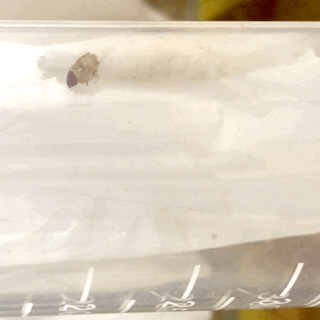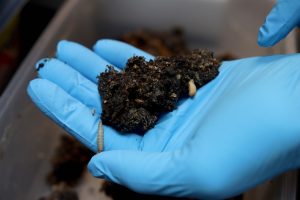BRANDON – Could humanity worm its way out of a major pollution problem?
That’s what Brandon University (BU) researchers are looking into as they study the ability of waxworms to eat plastic.
Dr. Christophe LeMoine and Dr. Bryan Cassone of BU’s Department of Biology have published their findings in Proceedings of the Royal Society B, a prestigious journal dedicated to biology. They found that waxworms, the caterpillar larvae of the greater wax moth, can survive on a diet of polyethylene, a type of plastic used in shopping bags and many other applications. Working with BU students Sachi Villanueva, Harald Grove and Oluwadara Elebute, the researchers isolated a species of intestinal bacteria in the worms that was able to survive on plastic for more than a year as its only source of nutrients.

“Plastic-eating bacteria are known, but in isolation they degrade plastics at a very slow rate,” Dr. LeMoine said. “Likewise, when we treated the caterpillars with antibiotics to reduce their gut bacteria, they were not able to degrade the plastic as easily. So it seems that there is a synergy between the bacteria and their waxworm hosts that accelerates plastic degradation.”
In fact, the study showed that feeding the waxworms a 100 per cent polyethylene diet increased the microbes in their guts when compared to worms that were fed their normal diet or were starved, suggesting the bacteria thrive on plastics. The researchers have dubbed these worms “plastivores.”
Glycol, a form of alcohol, was created as a byproduct of the plastic degradation. The researchers are still working to identify the exact nature of the end products.
“Worms that eat our plastic waste and turn it into alcohol sounds too good to be true. And in a way it is,” said Dr. Cassone. “The problem of plastic pollution is too large to simply throw worms at. But if we can better understand how the bacteria works together with the worm and what kind of conditions cause it to flourish, perhaps this information can be used to design better tools to eliminate plastics and microplastics from our environment.”
Drs. LeMoine and Cassone are continuing to study the waxworms as well as the bacteria to learn more about the characteristics that allow them to work so well together. The BU students, who are currently studying in the Master of Science (Environmental and Life Sciences) program, are also continuing to participate in the research. One of the students was still an undergraduate student when the study began.
“This is very intriguing research that is showing promising results as we tackle a worldwide problem,” said Dr. Bernadette Ardelli, Dean of Science at BU. “It’s very rewarding to see our faculty taking on important issues like this as well as to see our students gaining valuable experience, while also making their own contributions to an exciting discovery.”
Q & A
How do the waxworms digest the plastic?
The waxworms contain gut bacteria that biodegrade polyethylene. Isolated from one another, the bacteria and the waxworms can both degrade the plastic, but they are much more effective when working together.

What do waxworms normally eat?
Waxworms live in beehives, and, as the name suggests, they normally eat wax. The study has shown, however, that the waxworms can survive by eating only polyethylene, owing to their intestinal microbes.
How much plastic do they eat?
In the lab 60 waxworms can eat more than 30 square centimetres of a plastic bag in less than a week, the majority of it happening in the first few days.
What happens to the plastic?
Researchers have found that glycol, a type of alcohol, is one of the byproducts of the biodegradation. Whether there is any use for this glycol has yet to be determined.
How can this research be used?
It is impractical to expect that worms will simply eat all of our waste product. Likewise, the bacteria have been shown to be less effective when removed from the waxworms. Instead, gaining a better understanding of the bacteria as well as its synergistic relationship with the waxworms could assist in the development of better plastic biodegradation systems.
What happens to the waxworms?
The waxworms are caterpillars that form cocoons and emerge as greater wax moths. They do not eat as moths, however, doing all of their eating as caterpillars.
What is the next step in the research?
The researchers are continuing to study both the waxworms and the bacteria. By learning about their relationship, we can better understand what conditions can lead the bacteria to flourish and to maximize its potential to degrade plastic. We also can learn more about the mysterious waxworms and what allows them to survive on a “plastivore” diet.
Contact
- Brandon University
- communications@brandonu.ca
To receive any BU publication in an alternate format please contact Communications@BrandonU.ca
About BU
Success is built at Brandon University. Our growing, progressive campus welcomes a diverse and inclusive community that combines proud tradition with shared ambition. Through our excellence in teaching, research, and scholarship, we educate students to make a meaningful difference as engaged citizens and leaders. Join us at BrandonU.ca.